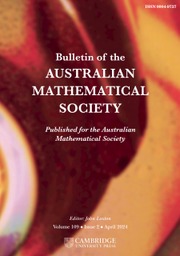No CrossRef data available.
Article contents
ON THE SHORTEST DISTANCE BETWEEN ORBITS IN CONFORMAL ITERATED FUNCTION SYSTEMS
Part of:
Smooth dynamical systems: general theory
Classical measure theory
Topological dynamics
Ergodic theory
Published online by Cambridge University Press: 11 November 2025
Abstract
Recently, Barros et al. [‘On the shortest distance between orbits and the longest common substring problem’, Adv. Math. 344 (2019), 311–339] adopted a dynamical system perspective to study the decay of the shortest distance between orbits. We calculate the Hausdorff dimensions of the exceptional sets arising from the shortest distance between orbits in conformal iterated function systems.
MSC classification
Information
- Type
- Research Article
- Information
- Copyright
- © The Author(s), 2025. Published by Cambridge University Press on behalf of Australian Mathematical Publishing Association Inc
Footnotes
The work was supported by the National Natural Science Foundation of China (12501109) and the Scientific Research Project of Colleges and Universities in Anhui Province (2024AH050016).
References
Arratia, R. and Waterman, M., ‘An Erdős–Rényi law with shifts’, Adv. Math. 55 (1985), 13–23.10.1016/0001-8708(85)90003-9CrossRefGoogle Scholar
Barros, V., Liao, L. M. and Rousseau, J., ‘On the shortest distance between orbits and the longest common substring problem’, Adv. Math. 344 (2019), 311–339.10.1016/j.aim.2019.01.001CrossRefGoogle Scholar
Barros, V. and Rousseau, J., ‘Shortest distance between multiple orbits and generalized fractal dimensions’, Ann. Henri Poincaré 22 (2021), 1853–1885.10.1007/s00023-021-01039-yCrossRefGoogle Scholar
Caby, T., ‘Matching of observations of dynamical systems, with applications to sequence matching’, Phys. D 440 (2022), Article no. 133456.10.1016/j.physd.2022.133456CrossRefGoogle Scholar
Chernov, N. and Kleinbock, D., ‘Dynamical Borel–Cantelli lemmas for Gibbs measures’, Israel J. Math. 122 (2001), 1–27.10.1007/BF02809888CrossRefGoogle Scholar
Coutinho, A., Lambert, R. and Rousseau, J., ‘Matching strings in encoded sequences’, Bernoulli 26 (2020), 2021–2050.10.3150/19-BEJ1181CrossRefGoogle Scholar
Falconer, K. J., Fractal Geometry. Mathematical Foundations and Applications, 3rd edn (John Wiley, Chichester, 2014).Google Scholar
Fan, S. L., Liao, L. M. and Qiu, Y. Q., ‘Stationary determinantal processes:
 $\psi$
-mixing property and correlation dimensions’, Stochastic Process. Appl. 151 (2022), 1–22.10.1016/j.spa.2022.05.009CrossRefGoogle Scholar
$\psi$
-mixing property and correlation dimensions’, Stochastic Process. Appl. 151 (2022), 1–22.10.1016/j.spa.2022.05.009CrossRefGoogle Scholar
Furstenberg, H., Recurrence in Ergodic Theory and Combinatorial Number Theory (Princeton University Press, Princeton, NJ, 1981).10.1515/9781400855162CrossRefGoogle Scholar
Galatolo, S., ‘Dimension via waiting time and recurrence’, Math. Res. Lett. 12 (2005), 377–386.10.4310/MRL.2005.v12.n3.a8CrossRefGoogle Scholar
Galatolo, S. and Peterlongo, P., ‘Long hitting time, slow decay of correlations and arithmetical properties’, Discrete Contin. Dyn. Syst. 27 (2010), 185–204.10.3934/dcds.2010.27.185CrossRefGoogle Scholar
Gouëzel, S., Rousseau, J. and Stadlbauer, M., ‘Minimal distance between random orbits’, Probab. Theory Related Fields 189 (2024), 811–847.10.1007/s00440-024-01283-3CrossRefGoogle Scholar
Hill, R. and Velani, S., ‘The ergodic theory of shrinking targets’, Invent. Math. 119 (1995), 175–198.10.1007/BF01245179CrossRefGoogle Scholar
Li, B., Liao, L. M., Velani, S. and Zorin, E., ‘The shrinking target problem for matrix transformations of tori: revisiting the standard problem’, Adv. Math. 421 (2023), Article no. 108994.10.1016/j.aim.2023.108994CrossRefGoogle Scholar
Mauldin, R. D. and Urbański, M., ‘Dimensions and measures in infinite iterated function systems’, Proc. Lond. Math. Soc. (3) 73 (1996), 105–154.10.1112/plms/s3-73.1.105CrossRefGoogle Scholar
Pawelec, L. and Urbański, M., ‘Long hitting times for expanding systems’, Nonlinearity 33 (2020), 942–970.10.1088/1361-6544/ab5170CrossRefGoogle Scholar
Rousseau, J., ‘Longest common substring for random subshifts of finite type’, Ann. Inst. Henri Poincaré Probab. Stat. 57 (2021), 1768–1785.10.1214/20-AIHP1130CrossRefGoogle Scholar
Shi, S. S., Tan, B. and Zhou, Q. L., ‘Best approximation of orbits in iterated function systems’, Discrete Contin. Dyn. Syst. 41 (2021), 4085–4104.10.3934/dcds.2021029CrossRefGoogle Scholar
Shi, S. S. and Zhou, Q. L., ‘On the shortest distance function in continued fractions’, Bull. Aust. Math. Soc. 109 (2024), 186–195.10.1017/S0004972723000503CrossRefGoogle Scholar
Todd, M. and Rousseau, J., ‘Orbits closeness for slowly mixing dynamical systems’, Ergodic Theory Dynam. Systems 19 (2023), 1–17.Google Scholar
Wang, B. W. and Wu, J., ‘Hausdorff dimension of the Cartesian product of limsup sets in Diophantine approximation’, Trans. Amer. Math. Soc. 377 (2024), 3727–3748.Google Scholar
Zhao, B. Y., ‘Closest distance between iterates of typical points’, Discrete Contin. Dyn. Syst. 44 (2024), 2252–2279.10.3934/dcds.2024026CrossRefGoogle Scholar


